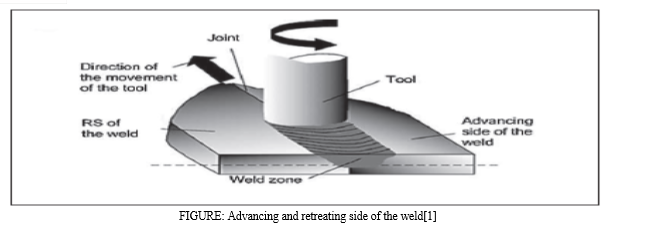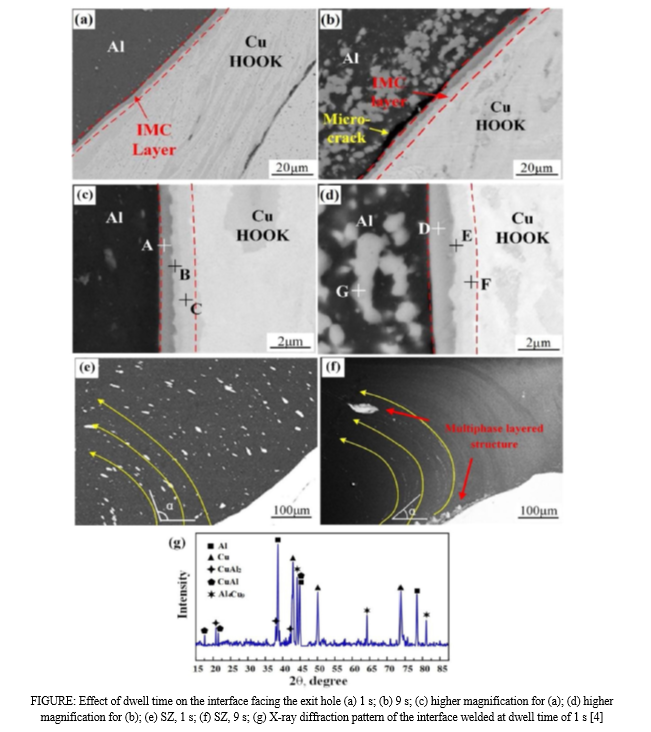Ijraset Journal For Research in Applied Science and Engineering Technology
- Home / Ijraset
- On This Page
- Abstract
- Introduction
- Conclusion
- References
- Copyright
The Copper Alloys Used in the Friction Stir Welding (FSW) Processes: A Review
Authors: Naresh Kumar, Dr. Rishi Dewangan
DOI Link: https://doi.org/10.22214/ijraset.2023.54268
Certificate: View Certificate
Abstract
Copper and its alloys possess a wide range of properties these make them valuable for many applications. There are several properties like as Good conductivity of electricity and heat is combined with strength, ductility and excellent corrosion resistance etc. Copper has made possible the continued, efficient development of the electrical industry because it has the highest conductivity of the commercial metals and it has good mechanical properties at low, ambient and elevated temperatures, is easily fabricated or cast to shape and can be joinned. The present paper analyzes the weld joint of pure copper which is made by using friction stir welding (FSW) process. The mechanism of thermo-mechanical processes of the FSW method has been studied and established a correlation between the weld zone and its microstructure. The various Parameters of the FSW welding processes influencing the zone of the base material and the mechanical properties of the resulting joint are analyzed.
Introduction
I. INTRODUCTION
The FSW welding technology was first introduced in 1991 by the The Welding Institute (TWI) to welding light metal alloys, primarily aluminium alloys [6].The modern technologies are gaining more importance in almost every field and Manufacturing industry not an exception. Welding has been a constant part of every manufacturing industry in which Automobile industry is the major partner[1].
Friction stir welding (FSW), as a low heat input solid state method, has been employed by researchers to overcome the problem of IMCs in dissimilar Al/Cu alloy joints. It is well documented that using a suitable combination of FSW parameters, i.e. a tool rotational speed, tool traverse speed, axial force, tool offset value, joint configuration, and etc., can control the thickness and morphology of the IMCs[2].
Aluminium based metal matrix composites (AMMCs) have developed increasing interest in structural applications inaerospace, transportation and defence due to their superior properties in comparison to conventional alloys and materials. Generally, AMMCs are largely fabricated via fusion based technologies. Producing AMMCs with fusion based practices leads to some typical problems such as particle clustering, casting related defects that significantly affects tensile strength, non-homogenous and unfavourable microstructure.
It is well known that during melting and at high temperatures interfacial reactions and formation of detrimental phases, segregation of reinforcement along the grain boundaries and their clustering occur[3].
Al and Cu can hardly achieve stabilization in electrical con-ductivity, the joining of Al and Cu by welding has been attracted much attention in the past decade. It is difficult to produce sound Al–Cu dissimilar joints by fusion welding due to their significant difference in chemical, physical and mechanical properties as well as high affinity to form brittle IMCs at high temperatures[4]. Multi-material systems have attracted wide attention owing to their improved properties from combining dissimilar materials. Many studies examined the mechanical properties, interfacial microstructure, and corrosion behavior of multi-material systems, such as Al/Fe structure.
In particular, the multi-material structures of Al and Cu have been widely researched in the field of welding engineering, there by reducing the cost and weight of electrical components[5].
A. Copper
Copper is a non-ferrous transition metal. Unlike brass and bronze, it is a pure, naturally occurring metal; therefore, it is found on the periodic table of elements.
It is among the few metals found in nature that is directly suitable for processing. Although it is used on its own, it is also combined with other pure metals and alloys to form its own subset of alloys.
B. Properties of Copper
Copper has several properties that make it ideal for construction and manufacturing, such as:
- Copper demonstrates excellent thermal and electrical conductivity, making it suitable for use in electronic and electrical systems and thermal equipment.
- It exhibits resistance to many forms of damage, including impact, wear, and corrosion. Additionally, it maintains its strength when flexed, formed, and drawn.
- Bacterial antimicrobial resistance.The material resists bacteria without degrading. It even kills bacteria that are exposed to its surface. This quality makes it ideal for use in food-safe equipment.
C. Available Grades of Copper
Copper’s availability in many different grades facilitates its versatility. At Sequoia Brass & Copper, they offer the following grades of copper:
- Alloy 101 This alloy is an oxygen-free copper, which is suitable for when manufacturers need high conductivity and ductility.
- Alloy 110 Also referred to as electrolytic (ETP) copper, this alloy demonstrates the highest level of electrical and thermal conductivity, as well as good ductility and malleability.
- Alloy 122 This alloy is mechanically similar to Alloy 110, but it also exhibits superior formability, weldability, and brazing capabilities. It is available in tubing from Sequoia Brass & Copper.
- Alloy 145 Available in rod & bar, this alloy is also known as tellurium copper as it consists of copper with between 0.4–0.7% tellurium content. Like many copper alloys, it is characterized by excellent thermal and electrical conductivity and high formability and superior machinability.
D. Applications of Copper Metal Sheets & Shapes
In general, copper offers excellent conductivity, formability, and machinability. These qualities make copper metal sheets suitable for a wide range of industrial applications, including use as architectural, construction, plumbing, and heat exchanger materials and components. Additionally, its high ductility allows sheets to be drawn into wires for electrical systems.




II. TOOL MATERIALS AND SELECTION
There are several tool materials that have been used in the FSW/P process as shown in the Table 1 and 2[7].
TABLE- 1
|
S. No. |
TOOL MATERIALS |
MATERIALS TO BE WELD |
References |
|
1. |
HCHCr |
AA5083-H111 Al alloy |
[7] |
|
2. |
SS310 |
Commercial grade Al-alloy 6 mm thick |
[7] |
|
3. |
H13 |
AA5754 and C11000 copper 3.175 mm thick |
[7] |
|
4. |
HSS |
AA2011 and AA6063 alloys10 mm thick |
[7] |
|
5. |
C40 |
AA6082 and AA2024 4 mm thick |
[7] |
|
6. |
H13 |
6061-T6 Al and AISI 1018 mild steel 6 mm thickness |
[7] |
Tool materials and suitable weld metals.
|
S. No. |
Tool Material |
Suitable weld material |
References |
|
1. |
Tool steels |
Al alloys, aluminium metal matrix composites (AMCs) and copper alloys |
[7] |
|
2. |
WC -Co |
Aluminium alloys, mild steel |
[7] |
|
3. |
Ni-Alloys |
Copper alloys |
[7] |
|
4. |
WC composite |
Aluminium alloys, low alloy steel and magnesium alloys, Ti-alloys |
[7] |
|
5. |
W-alloys |
Titanium alloys, stainless steel and copper alloys |
[7] |
|
6. |
PCBN |
Copper alloys, stainless steels and nickel alloys |
[7] |
A. Desired FSW Process tool Material Characteristics
To produce a high quality FSW joint, it is a requirement that the tool material selection is done properly. The characteristics that have to be considered in choosing the tool material for FSW process include[7].
- Resistance to wear.
- No harmful reactions with the weld metal.
- Good strength, dimensional stability and creep resistance at ambient and elevated temperature.
- Good thermal fatigue strength to resist repeated thermal cycles.
- Good fracture toughness to resist the damage during plunging and dwelling.
- Low coefficient of thermal expansion.
- Good machinability for the manufacture of complex features on the shoulder and probe.
III. MATERIAL FLOW IN WELDING ZONE
The material flow during FSW is divided into two kinds of flow as given below. [6]
- Material flow due to pin: layer by layer
- Material flow due to shoulder: material from retreating side(RS) is transferred through the shoulder surface at the top of the advancing side (AS).



Conclusion
The present study has identified the various issues related to the welding parameters influencing and the microstructure of the welded copper joint using the FSW process. Heat inducing mechanisms has been studied for the copper and its alloys for the FSW welding processes. Further, zones of influence and the structure of the welded copper-alloy joint are studied. It has been founded that the shoulder face of the tool generates thermal energy that preheats the material and creates conditions for quality welding. The welding joint of good quality has the same Mechanical Properties as the base material. At last , this is concluded that copper and its alloys with different alloying materials can be joined by Friction stir welding process(FSW/P) with great quality weld effectively.
References
[1] M. Mili?i?, P. Gladovi?, R. Bojani?, T. Savkovi?, and N. Stoji?, “Friction stir welding (FSW) process of copper alloys,” Metalurgija, vol. 55, no. 1, pp. 107–110, 2016. [2] R. Khajeh et al., “Strength-ductility synergic enhancement in friction stir welded AA2024 alloy and copper joints: Unravelling the role of Zn interlayer’s thickness,” J. Mater. Res. Technol., vol. 16, pp. 251–262, 2022, doi: 10.1016/j.jmrt.2021.11.133. [3] N. Gangil, S. Maheshwari, A. N. Siddiquee, M. H. Abidi, M. A. El-Meligy, and J. A. Mohammed, “Investigation on friction stir welding of hybrid composites fabricated on Al-Zn-Mg-Cu alloy through friction stir processing,” J. Mater. Res. Technol., vol. 8, no. 5, pp. 3733–3740, 2019, doi: 10.1016/j.jmrt.2019.06.033. [4] G. Li, L. Zhou, W. Zhou, X. Song, and Y. Huang, “Influence of dwell time on microstructure evolution and mechanical properties of dissimilar friction stir spot welded aluminum-copper metals,” J. Mater. Res. Technol., vol. 8, no. 3, pp. 2613–2624, 2019, doi: 10.1016/j.jmrt.2019.02.015. [5] K. Kurabayashi, S. Tokita, and Y. S. Sato, “Effect of Ni Addition on the Interfacial Strength of Al/Cu Dissimilar Welds Produced by Friction Stir Lap Welding,” Metals (Basel)., vol. 12, no. 3, 2022, doi: 10.3390/met12030453. [6] K. Yugandha, P. S. Balaji, P. Chandu, R. V. Prasanna, M. N. Magesh, and T. G. Loganathan, “a Study on Fsw Parameters of Joining Dissimilar Metals - Al and Fe,” Int. J. Trendy Res. Eng. Technol., vol. 06, no. 01, 2022, doi: 10.54473/ijtret.2022.6104. [7] K. Chiteka, “Friction Stir Welding/Processing Tool Materials and Selection,” Int. J. Eng. Res. Technol., vol. 2, no. 11, pp. 8–18, 2013. [8] W. SONG, D. ZUO, Y. SHI, H. WANG, and J. PU, “EBSD and Raman Spectroscopy Analysis of Copper Alloy H62/GOp-modified Layer Prepared by Friction Stir Surface Processing,” Mater. Sci., vol. XX, no. X, 2022, doi: 10.5755/j02.ms.30239. [9] S. Lee, Y. Park, and Y. Lee, “Materials Science and Engineering A,” vol. 515, no. 3, pp. 32–37, 2009. [10] T. O. Olugbade, B. O. Omiyale, and O. T. Ojo, “Corrosion, Corrosion Fatigue, and Protection of Magnesium Alloys: Mechanisms, Measurements, and Mitigation,” J. Mater. Eng. Perform., no. October, 2021, doi: 10.1007/s11665-021-06355-2. [11] A. Forcellese, T. Mancia, M. Pieralisi, and A. Vita, “Friction stir welding of additively manufactured blanks in thermoplastic polymer,” Procedia CIRP, vol. 112, pp. 448–453, 2022, doi: 10.1016/j.procir.2022.09.035. [12] C. Rathinasuriyan, S. Muniamuthu, A. Mystica, and V. S. Senthil Kumar, “Investigation of heat generation during submerged friction stir welding on 6061-T6 aluminum alloy,” Mater. Today Proc., vol. 46, no. April, pp. 8320–8324, 2021, doi: 10.1016/j.matpr.2021.03.310. [13] S. Verma, Meenu, and J. P. Misra, “Study on temperature distribution during Friction Stir Welding of 6082 aluminum alloy,” Mater. Today Proc., vol. 4, no. 2, pp. 1350–1356, 2017, doi: 10.1016/j.matpr.2017.01.156. [14] M. Li, C. Zhang, D. Wang, L. Zhou, D. Wellmann, and Y. Tian, “Friction stir spot welding of aluminum and copper: A review,” Materials (Basel)., vol. 13, no. 1, p. 156, 2020, doi: 10.3390/ma13010156. [15] R. P. Singh, S. Dubey, A. Singh, and S. Kumar, “A review paper on friction stir welding process,” Mater. Today Proc., vol. 38, no. March 2016, pp. 6–11, 2020, doi: 10.1016/j.matpr.2020.05.208. [16] F. Stir, W. Fsw, and B. Meyghani, “The Influence of the Tool Tilt Angle on the Heat Generation and,” 2022. [17] S. Memon, D. Fydrych, A. C. Fernandez, H. A. Derazkola, and H. A. Derazkola, “Effects of fsw tool plunge depth on properties of an al-mg-si alloy t-joint: Thermomechanical modeling and experimental evaluation,” Materials (Basel)., vol. 14, no. 16, 2021, doi: 10.3390/ma14164754. [18] T. Majeed, Y. Mehta, and A. N. Siddiquee, “Challenges in joining of unequal thickness materials for aerospace applications: A review,” Proc. Inst. Mech. Eng. Part L J. Mater. Des. Appl., vol. 235, no. 4, pp. 934–945, 2021, doi: 10.1177/1464420720978682. [19] I. S. Zuiko, S. Mironov, and R. Kaibyshev, “Unusual ageing behaviour of friction-stir welded Al–Cu–Mg alloy,” Mater. Sci. Eng. A, vol. 793, no. July, p. 139882, 2020, doi: 10.1016/j.msea.2020.139882. [20] J. Entringer, M. Reimann, A. Norman, and J. F. Dos Santos, “Influence of Cu/Li ratio on the microstructure evolution of bobbin-tool friction stir welded Al-Cu-Li alloys,” J. Mater. Res. Technol., vol. 8, no. 2, pp. 2031–2040, 2019, doi: 10.1016/j.jmrt.2019.01.014. [21] G. ju Zhang, C. yuan Xiao, and O. O. Ojo, “Dissimilar friction stir spot welding of AA2024-T3/AA7075-T6 aluminum alloys under different welding parameters and media,” Def. Technol., vol. 17, no. 2, pp. 531–544, 2021, doi: 10.1016/j.dt.2020.03.008. [22] R. Burek, D. Wydrzy?ski, J. S?p, and W. Wi?ckowski, “The effect of tool wear on the quality of lap joints between 7075 T6 aluminum alloy sheet metal created with the FSW method,” Eksploat. i Niezawodn., vol. 20, no. 1, pp. 100–106, 2018, doi: 10.17531/ein.2018.1.13.
Copyright
Copyright © 2023 Naresh Kumar, Dr. Rishi Dewangan. This is an open access article distributed under the Creative Commons Attribution License, which permits unrestricted use, distribution, and reproduction in any medium, provided the original work is properly cited.

Download Paper
Paper Id : IJRASET54268
Publish Date : 2023-06-20
ISSN : 2321-9653
Publisher Name : IJRASET
DOI Link : Click Here
 Submit Paper Online
Submit Paper Online

